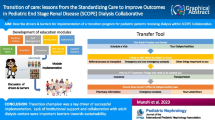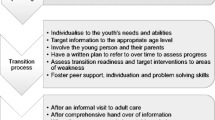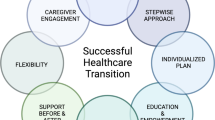Abstract
Background
There is increasing focus on the problems involved in the transition and transfer of young adult patients from paediatric to adult renal units. This situation was addressed by the 2011 International Pediatric Nephrology Association/International Society of Nephrology (IPNA/ISN) Consensus Statement on transition.
Methods
We performed a survey of transition practices of 15 paediatric nephrology units across Europe 2 years after publication of the consensus statement.
Results
Two thirds of units were aware of the guidelines, and one third had integrated them into their transition practice. Forty-seven per cent of units transfer five or fewer patients with chronic kidney disease (CKD) stage 5 per year to a median of five adult centres, with higher numbers of CKD stages 2–4 patients. Seventy-three per cent of units were required by the hospital or government to transfer patients by a certain age. Eighty per cent of units commenced transition planning after the patient turned 15 years of age and usually within 1–2 years of the compulsory transfer age. Forty-seven per cent of units used a transition or transfer clinic. Prominent barriers to effective transition were patient and parent attachment to the paediatric unit and difficulty in allowing the young person to perform self-care.
Conclusions
Whereas awareness of the consensus statement is suboptimal, it has had some impact on practice. Adult nephrologists receive transferred patients infrequently, and the process of transition is introduced too late by paediatricians. Government- and hospital-driven age-based transfer policies distract focus from the achievement of competencies in self care. Variable use of transition clinics, written patient information and support groups is probably due to economic and human-resource limitations. The consensus statement provides a standard for evolving and evaluating transition policies jointly agreed upon by paediatric and adult units.


Similar content being viewed by others
Abbreviations
- CKD:
-
Chronic kidney disease
- IPNA:
-
International Pediatric Nephrology Association
- ISN:
-
International Society of Nephrology
References
Watson AR (2012) Continuity in transition from paediatric to adult healthcare. J R Coll Physicians Edinb 42:3–4
Pruthi R, Sinha MD, Casula A. Tse Y, Maxwell H, OBrien C, Lewis M, Inward C (2012) Demography of the UK paediatric renal replacement therapy population in 2010. In: UK Renal Registry 2011 14th Annual Report of the Renal Association. 14th edn. Bristol, UK, p 101–111. http://www.renalreg.com/Reports/2011.html
Pruthi R, O’Brien C, Casula A Braddon F, Lewis M, Maxwell H, Tse Y, Inward C, Sinha M (2013) Demography of the Paediatric Renal Replacement Therapy Population in 2011. In: UK Renal Registry 2012 15th Annual Report of the Renal Association. 15th edn. Bristol, UK. p 87–98. http://www.renalreg.com/Reports/2012.html
Watson AR, Harden P, Ferris M, Kerr PG, Mahan J, Ramzy MF (2011) Transition from pediatric to adult renal services: a consensus statement by the International Society of Nephrology (ISN) and the International Pediatric Nephrology Association (IPNA). Pediatr Nephrol 26:1753–1757
Watson AR (2000) Non-compliance and transfer from paediatric to adult transplant unit. Pediatr Nephrol 14:469–472
Keith DS, Cantarovich M, Paraskevas S, Tchervenkov J (2006) Recipient age and risk of chronic allograft nephropathy in primary deceased donor kidney transplant. Transpl Int 19:649–656
Magee JC, Krishnan SM, Benfield MR, Hsu DT, Shneider BL (2008) Pediatric transplantation in the United States, 1997–2006. Am J Transplant 8:935–945
Ferris ME, Gipson DS, Kimmel PL, Eggers PW (2006) Trends in treatment and outcomes of survival of adolescents initiating end-stage renal disease care in the United States of America. Pediatr Nephrol 21:1020–1026
Sawyer SM, Drew S, Yeo MS, Britto MT (2007) Adolescents with a chronic condition: challenges living, challenges treating. Lancet 369:1481–1489
Rosen D (1995) Between two worlds: bridging the cultures of child health and adult medicine. J Adolesc Health 17:10–16
Watson AR (2005) Problems and pitfalls of transition from paediatric to adult renal care. Pediatr Nephrol 20:113–117
What is adolescence? US Department of Health and Human Services. http://www.hhs.gov/opa/familylife/tech_assistance/etraining/adolescent_brain/Overview/what_is_adolescence/ (accessed Jul 2013)
Viner R (2013) Adolescents’ health needs: the same the world over. Arch Dis Child 98:2
Gilleland J, Amaral S, Mee L, Blount R (2012) Getting ready to leave: transition readiness in adolescent kidney transplant recipients. J Pediatr Psychol 37:85–96
Harden PN, Walsh G, Bandler N, Bradley S, Lonsdale D, Taylor J, Marks SD (2012) Bridging the gap: an integrated paediatric to adult clinical service for young adults with kidney failure. BMJ 344:e3718–e3718
Paone M, Wigle M, Saewyc E (2006) The ON TRAC model for transitional care of adolescents. Prog Transplant 16:291–302
Grant C, Pan J (2011) A comparison of five transition programmes for youth with chronic illness in Canada. Child Care Health Dev 37:815–820
Schwartz L, Tuchman L, Hobbie W, Ginsberg J (2011) A socio-ecological model of readiness for transition to adult-oriented care for adolescents and young adults with chronic health conditions. Child Care Health Dev 37:883–895
Prestidge C, Romann A, Djurdjev O, Matsuda-Abedini M (2012) Utility and cost of a renal transplant transition clinic. Pediatr Nephrol 27:295–302
Bell LE, Bartosh SM, Davis CL, Dobbels F, Al-Uzri A, Lotstein D, Reiss J, Dharnidharka VR (2008) Adolescent transition to adult care in solid organ transplantation: a consensus conference report. Am J Transplant 8:2230–2242
(2009) Helping adolescents and young adults with end stage renal failure. British Association for Pediatric Nephrology/Renal Association. http://www.bapn.org/clinical-standards.html (Accessed Jun 2013)
Webb N, Harden P, Lewis C, Tizzard S, Walsh G, Wray J, Watson A (2010) Building consensus on transition of transplant patients from paediatric to adult healthcare. Arch Dis Child 95:606–611
Ellrodt AG, Conner L, Riedinger M, Weingarten S (1995) Measuring and improving physician compliance with clinical practice guidelines: a controlled interventional trial. Ann Intern Med 122:277–282
Dean A, Davis DA, Taylor-Vaisey A (1997) Translating guidelines into practice: a systematic review of theoretical concepts, practical experience and research evidence in the adoption of clinical practice guidelines. Can Med Assoc J 157:408–416
Ferris M, Harward D, Bickford K, Layton JB, Ferris MT, Hogan SL, Gipson DS, McCoy LP, Hooper SR (2012) A clinical tool to measure components of health-care transition from pediatric care to adult care: the TR(x)ANSITION scale. Ren Fail 34:744–753
Fernandes SM, Sullivan-Oliveira JO, Ziniel S, Melvin P, KhairyP O’BR, Webster RA, Landzberg MJ, Sawicki GS (2010) Current practices for the transition and transfer of patients with a wide spectrum of pediatric onset chronic diseases: results of a clinician survey at a free standing pediatric hospital. Int J Child Adolesc Health 3(4):507–515
Giedd J (2008) The teen brain: insights from neuroimaging. J Adolesc Health 42:335–343
Blakemore S (2012) Development of the social brain in adolescence. J R Soc Med 105:111–116
Watson A, Hilton D, Hackett D (2010) Therapeutic recreation camps to provide a residential experience for young people in transition to adult renal units. Pediatr Nephrol 25:787–788
Chaturvedi S, Jones CL, Walker RG, Sawyer SM (2009) The transition of kidney transplant recipients: a work in progress. Pediatr Nephrol 24:1055–1060
Wong LHL, Chan FWK, Wong FYY, Wong ELY, Huen K, Yeoh EK, Fok T (2010) Transition care for adolescents and families with chronic illnesses. J Adolesc Health 47:540–546
Pape L, Lämmermühle J, Oldhafer M, Blume C, Weiss R, Ahlenstiel T (2013) Different models of transition to adult care after pediatric kidney transplantation: A comparative study. Pediatr Transplant 17:518–524
Drawz PE, Miller RT, Singh S, Watts B, Kern E (2012) Impact of a chronic kidney disease registry and provider education on guideline adherence—a cluster randomized controlled trial. BMC Med Inform Decis Mak 12:62–69
Dovey-Pearce G, Christie D (2013) Transition in diabetes: young people move on—we should too. Paediatr Child Health 23:174–179
Watson AR (2004) Hospital youth work and adolescent support. Arch Dis Child 89:440–442
Author information
Authors and Affiliations
Consortia
Corresponding author
Rights and permissions
About this article
Cite this article
Forbes, T.A., Watson, A.R., Zurowska, A. et al. Adherence to transition guidelines in European paediatric nephrology units. Pediatr Nephrol 29, 1617–1624 (2014). https://doi.org/10.1007/s00467-014-2809-4
Received:
Revised:
Accepted:
Published:
Issue Date:
DOI: https://doi.org/10.1007/s00467-014-2809-4




